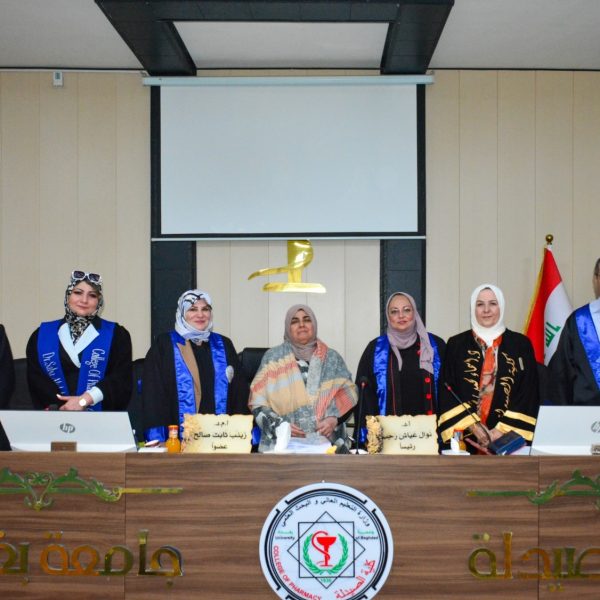The College of Pharmacy discussed the Ph.D. dissertation entitled “Nimodipine Loaded Nanoparticles as Transdermal Bilayer Dissolved Microneedles Patches: Preparation, In-vitro and In-vivo Evaluation” by the student Asmaa Mohammed Rashid and the supervisor, Professor. Dr. Mowafaq M. Ghareeb, at the Pharmaceutics Department. The goals of the study were to gain insight into the ability of microneedles to deliver nanoencapsulated drugs across the skin, reaching systemic circulation by combining the advantages of the two approaches, polymeric nanoparticles (PNPs) and microneedling, thus achieving the improvement of NID pharmacokinetics (Cmax and Tmax) by avoiding metabolic processes and consequently increasing its bioavailability. Thirty-six formulas of PNPs containing 30 mg NID have been prepared via the nanoprecipitation method, employing different polymers and surfactants as stabilizers. The physical properties of the prepared nanoparticles, such as particle size (PS), distribution, entrapment efficiency (EE), and in vitro release, were studied; in addition, the morphological properties were inspected by atomic force microscope (AFM) and field emission-scanning electron microscope (FE-SEM). Ten formulas of bilayer-dissolving MNs incorporated with optimized NPs were prepared utilizing a micro-molding method; different water-soluble polymers were used. Formulas were evaluated in terms of morphology, dimensions, mechanical strength, insertion properties, moisture content, permeation-enhancing effect, and in vivo study. The outcomes indicated that NPs were successfully prepared through the nanoprecipitation method with properly selected components.The obtained particles were ranged between (81.53 to 449.5 nm), and the distribution ranged from (0.93 to 0.046) with a relatively high entrapment efficiency range between (99% to 63.14%). The AFM and FE-SEM study for the best formula (F24) prepared with Soluplus with a 1:8 drug:polymer ratio and stabilized with 0.25% w/v PVPK15 confirms its spherical shape. The results showed that among the different polymers used to prepare bilayer dissolving MNs formulas, FMN2 prepared from 10% w/v PVA, plasticized with 5% glycerol, exhibited inferior mechanical strength, with a peak force value of 59.2N that was sufficient to pierce Parafilm M®, a widely used human skin simulant.The in vivo studies in rabbits showed that the maximum plasma concentration (Cmax) and the time to reach that concentration (Tmax) were 64.66 ng/ml, 0.40 h, and 51947.56 ng.h/ml, respectively, for transdermal NID-loaded bilayer dissolving MNs. Therefore, results showed that the relative bioavailability for the transdermal route was approximately two times that of the oral route calculated after a single dose administration. The study demonstrated that the transdermal nimodipine-loaded bilayer dissolving microneedles have the potential to increase therapeutic efficacy, proving an approach that is pain-free, noninvasive, more convenient, and more accepted than traditional medication systems.





